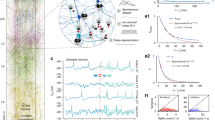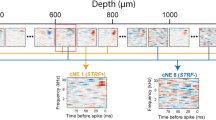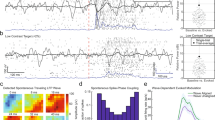Abstract
Cortical neurons in the waking brain fire highly irregular, seemingly random, spike trains in response to constant sensory stimulation, whereas in vitro they fire regularly in response to constant current injection. To test whether, as has been suggested, this high in vivo variability could be due to the postsynaptic currents generated by independent synaptic inputs, we injected synthetic synaptic current into neocortical neurons in brain slices. We report that independent inputs cannot account for this high variability, but this variability can be explained by a simple alternative model of the synaptic drive in which inputs arrive synchronously. Our results suggest that synchrony may be important in the neural code by providing a means for encoding signals with high temporal fidelity over a population of neurons.
This is a preview of subscription content, access via your institution
Access options
Subscribe to this journal
Receive 12 print issues and online access
$209.00 per year
only $17.42 per issue
Buy this article
- Purchase on Springer Link
- Instant access to full article PDF
Prices may be subject to local taxes which are calculated during checkout





Similar content being viewed by others
References
Softky, W. & Koch, C. The highly irregular firing of cortical cells is inconsistent with temporal integration of random epsps. J. Neurosci. 13, 334–350 (1993).
Mainen, Z.F. & Sejnowski, T.J. Reliability of spike timing in neocortical neurons. Science 268, 1503– 1505 (1995).
Zador, A. The impact of synaptic unreliability on the information transmitted by spiking neurons. J. Neurophysiol. 19, 1230–1238 (1998).
Calvin, W.H. & Stevens, C.F. Synaptic noise and other sources of randomness in motoneuron interspike intervals. J. Neurophysiol. 31, 574–587 ( 1968).
Shadlen, M.N. & Newsome, W.T. Is there a signal in the noise? Curr. Opin. Neurobiol. 5, 248– 250 (1995).
Shadlen, M.N. & Newsome, W.T. The variable discharge of cortical neurons: Implications for connectivity, computation, and information coding . J. Neurosci. 18, 3870– 3896 (1998).
Troyer, T.W. & Miller, K.D. Physiological gain leads to high ISI variability in a simple model of a cortical regular spiking cell. Neural Computation 9, 971–983 (1997).
Nowak, L.G., Sanchez-Vives, M.V. & McCormick, D.A. Influence of low and high frequency inputs on spike timing in visual cortical neurons. Cereb. Cortex 7, 487–501 (1997).
Berretta, B. & Jones, S.G. A comparison of spontaneous EPSCs in layer II and layer IV-V neurons of the rat entorhinal cortex in vitro. J. Neurophysiol. 76, 1089–1100 (1996).
Burgard, E.C. & Hablitz, J.J. NMDA receptor-mediated components of miniature excitatory synaptic currents in developing rat neocortex. J. Neurophysiol. 70, 1841–1852 (1993).
Bekkers, J.M., Richerson, G.B. & Stevens, C.F. Origin of variability in quantal size in cultured hippocampal neurons and hippocampal slices. Proc. Natl Acad. Sci. USA 87, 5359–5362 (1990).
Feller, W. An Introduction to Probability Theory and its Applications, vol. 2, 2nd edn. (Wiley, New York, 1971).
Burns, B.D. & Webb, A.C. The spontaneous activity of neurones in the cat's cerebral cortex. Proc. Royal Soc. Lond. B 194, 211–223 (1976).
Holt, G.R. Softky, W.R., Koch, C. & Douglas, R.J. Comparison of discharge variability in vitro and in vivo in cat visual cortex neurons. J. Neurophysiol. 75, 1806–1814 (1996).
Noda, H. & Adey, R. Firing variability in cat association cortex during sleep and wakefulness. Brain Res. 18, 513–526 (1970).
Buracas, G., Zador, A., Deweese, M. & Albright, T. Efficient discrimination of temporal patterns by motion-sensitive neurons in primate visual cortex . Neuron 20, 959–969 (1998).
Berman, N.J., Douglas, R.J., Martin, K.A. & Whitteridge, D. Mechanisms of inhibition in cat visual cortex. J. Physiol. 440 , 697–722 (1991).
Nelson, S., Toth, L., Sheth, B. & Sur, M. Orientation selectivity of cortical neurons during intracellular blockade of inhibition. Science 265, 774–777 ( 1994).
Gershon, E.D., Wiener, M.C., Latham, P.E. & Richmond, B.J. Coding strategies in monkey V1 and inferior temporal cortices. J. Neurophysiol. 79, 1135–1144 (1998).
Sharp, A.A., O'Neil, M.B., Abbott, L.F. & Marder, E. Dynamic clamp: computer-generated conductances in real neurons. J. Neurophysiol. 3, 992–995 (1993).
Hubbard, J.I., Jones, S.F. & Landau, E.M. An examination of the effects of osmotic pressure changes upon transmitter release from mammalian motor nerve terminals. J. Physiol. 197, 639–657 (1968).
Stevens, C.F. & Tsujimoto, T. Estimates for the pool size of releasable quanta at a single central synapse and for the time required to refill the pool. Proc. Natl Acad. Sci. USA 92, 846–849 (1995).
Abeles, M. Corticonics--Neural Circuits of the Cerebral Cortex. (Cambridge Univ. Press, 1991).
Alonso, J.M., Usrey, W.M. & Reid, R.C. Precisely correlated firing in cells of the lateral geniculate nucleus. Nature 383, 815–819 ( 1996).
deCharms, R.C. & Merzenich, M.M. Primary cortical representation of sounds by the coordination of action-potential timing. Nature 381, 610–613 ( 1996).
Nelson, J.I., Salin, P.A., Munk, M.H., Arzi, M. & Bullier, J. Spatial and temporal coherence in cortico-cortical connections: a cross-correlation study in areas 17 and 18 in the cat. Visual Neurosci. 9, 21–37 ( 1992).
Singer, W. & Gray, C.M. Visual feature integration and the temporal correlation hypothesis. Ann. Rev. Neurosci. 18, 555–586 (1995).
Usher, M., Stemmler, M., Koch, C. & Olami, Z. Network amplification of local fluctuations causes high spike rate variability, fractal firing patterns and oscillatory local field potentials. Neural Computation 6, 795–836 (1994).
van Vreeswijk, C. & Sompolinsky, H. Chaos in neuronal networks with balanced excitatory and inhibitory activity. Science 274, 1724–1726 (1996).
Whittington, M.A., Traub, R.D., Faulkner, H.J., Stanford, I.M. & Jefferys, J.G. Recurrent excitatory postsynaptic potentials induced by synchronized fast cortical oscillations. Proc. Natl Acad. Sci. USA 94, 12198– 12203 (1997).
Zohary, E., Shadlen, M.N. & Newsome, W.T. Correlated neuronal discharge rate and its implications for psychophysical performance. Nature 370, 140–143 (1994).
Shadlen, M.N. & Newsome, W.T. Noise, neural codes and cortical organization. Curr. Opin. Neurobiol. 4, 569–579 (1994).
Softky, W.R. Simple codes versus efficient codes. Curr. Opin. Neurobiol. 5, 239–247 (1995).
Reich, D.S., Victor, J.D., Knight, B.W., Ozaki, T. & Kaplan, E. Response variability and timing precision of neuronal spike trains in vivo. J. Neurophysiol. 77, 2836–2841 (1997).
Tang, A.C., Bartels, A.M. & Sejnowski, T.J. Effects of cholinergic modulation on responses of neocortical neurons to fluctuating inputs. Cereb. Cortex 7, 502–509 (1997).
Softky, W.R. Sub-millisecond coincidence detection in active dendritic trees. Nature Neuroscience 58, 13–41 (1994).
Hausser, M. & Clark, B.A. Tonic synaptic inhibition modulates neuronal output pattern and spatiotemporal synaptic integration. Neuron 19, 665–678 ( 1997).
Markram, H. A network of tufted layer 5 pyramidal neurons. Cereb. Cortex 7, 523–533 (1997).
Bialek, W., Rieke, F., de Ruyter van Steveninck, R.R. & Warland, D. Reading a neural code. Science 252, 1854 –1857 (1991).
Rieke, F., Warland, D., de Ruyter van Steveninck, R.R. & Bialek, W. Spikes: Exploring the Neural Code. (MIT Press, 1997 ).
Bair, W. & Koch, C. Temporal precision of spike trains in extrastriate cortex of the behaving macaque monkey. Neural Computation 8, 1184–1202 (1996).
Stuart, G.J., Dodt, H.U. & Sakmann, B. Patch-clamp recordings from the soma and dendrites of neurons in brain slices using infrared video microscopy. Pflug. Archiv. Eur. J. Physiol. 423, 511–518 ( 1993).
McCormick, D.A., Connors, B.W., Lighthall, J.W. & Prince, D.A. Comparative electrophysiology of pyramidal and sparsely spiny stellate neurons of the neocortex. J. Neurophysiol. 54, 782 –806 (1985).
Acknowledgements
We thank G. Buracas for the MT data and L. Dobrunz, E. Huang, K. Miller, P. Latham, T. Troyer and K. Zhang for comments. This work was supported by the Howard Hughes Medical Institute (C.F.S.), National Institutes of Health grant NS 12961 (C.F.S.) and the Sloan Center for Theoretical Neurobiology (A.M.Z.).
Author information
Authors and Affiliations
Corresponding author
Rights and permissions
About this article
Cite this article
Stevens, C., Zador, A. Input synchrony and the irregular firing of cortical neurons. Nat Neurosci 1, 210–217 (1998). https://doi.org/10.1038/659
Received:
Accepted:
Issue Date:
DOI: https://doi.org/10.1038/659
This article is cited by
-
Gene losses, parallel evolution and heightened expression confer adaptations to dedicated cleaning behaviour
BMC Biology (2023)
-
Increased intrinsic and synaptic excitability of hypothalamic POMC neurons underlies chronic stress-induced behavioral deficits
Molecular Psychiatry (2023)
-
Spontaneous and information-induced bursting activities in honeybee hives
Scientific Reports (2023)
-
Modeling and characterization of stochastic resistive switching in single Ag2S nanowires
Scientific Reports (2022)
-
Information diversity in individual auditory cortical neurons is associated with functionally distinct coordinated neuronal ensembles
Scientific Reports (2021)



